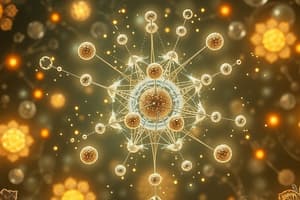Podcast
Questions and Answers
What occurs when metals react with non-metals?
What occurs when metals react with non-metals?
- Gaseous products are produced
- Neutral elements remain
- Ionic compounds are created (correct)
- Covalent bonds are formed
What is formed when an atom loses one or more electrons?
What is formed when an atom loses one or more electrons?
- Anion
- Cation (correct)
- Neutral Atom
- Isotope
Cations are formed when an atom gains electrons.
Cations are formed when an atom gains electrons.
False (B)
Atoms that gain electrons become cations.
Atoms that gain electrons become cations.
What is the charge of an anion?
What is the charge of an anion?
What is the primary reason for the formation of ionic bonds?
What is the primary reason for the formation of ionic bonds?
To achieve a stable electron configuration, non-metals typically ______ electrons.
To achieve a stable electron configuration, non-metals typically ______ electrons.
A metal tends to ______ electrons in a reaction.
A metal tends to ______ electrons in a reaction.
Which of the following statements is true about electron configuration stability?
Which of the following statements is true about electron configuration stability?
Match the following terms with their descriptions:
Match the following terms with their descriptions:
What role do non-metals play in ionic bonding?
What role do non-metals play in ionic bonding?
Which of the following properties is typical of ionic compounds?
Which of the following properties is typical of ionic compounds?
Match the following elements with their typical ionic charge:
Match the following elements with their typical ionic charge:
It is easier for sodium to gain electrons than to lose electrons.
It is easier for sodium to gain electrons than to lose electrons.
What is required to break the bonds in ionic compounds?
What is required to break the bonds in ionic compounds?
Ionic bonds involve the sharing of electrons between atoms.
Ionic bonds involve the sharing of electrons between atoms.
What do metals do to achieve a more stable electron arrangement?
What do metals do to achieve a more stable electron arrangement?
Non-metals can gain electrons to become positively charged ions.
Non-metals can gain electrons to become positively charged ions.
What term is used for positively charged ions formed by metals?
What term is used for positively charged ions formed by metals?
The stable arrangement of electrons in an atom is achieved by gaining or losing __________.
The stable arrangement of electrons in an atom is achieved by gaining or losing __________.
Which of the following elements would most likely become a cation?
Which of the following elements would most likely become a cation?
The lattice structure of ionic compounds results from the attraction between cations and anions.
The lattice structure of ionic compounds results from the attraction between cations and anions.
What happens to a sodium atom when it loses one electron?
What happens to a sodium atom when it loses one electron?
Metal atoms are generally __________ charged after losing electrons.
Metal atoms are generally __________ charged after losing electrons.
Which factor contributes to the reactivity of metals?
Which factor contributes to the reactivity of metals?
Flashcards
Ion
Ion
An electrically charged atom or group of atoms.
Ionic bond
Ionic bond
Bond formed by the loss or gain of electrons.
Dot and cross diagrams
Dot and cross diagrams
Diagrams showing the arrangement of outer-shell electrons in compounds or elements.
Covalent bond
Covalent bond
Signup and view all the flashcards
Atom
Atom
Signup and view all the flashcards
Element
Element
Signup and view all the flashcards
Compound
Compound
Signup and view all the flashcards
Outer-shell electrons
Outer-shell electrons
Signup and view all the flashcards
Ionic compounds
Ionic compounds
Signup and view all the flashcards
Properties of ionic compounds (physical)
Properties of ionic compounds (physical)
Signup and view all the flashcards
Metal reaction with nonmetal
Metal reaction with nonmetal
Signup and view all the flashcards
Electron transfer
Electron transfer
Signup and view all the flashcards
High melting/boiling points
High melting/boiling points
Signup and view all the flashcards
Electrostatic forces
Electrostatic forces
Signup and view all the flashcards
Atom electron gain
Atom electron gain
Signup and view all the flashcards
Electron gain
Electron gain
Signup and view all the flashcards
Metal ion
Metal ion
Signup and view all the flashcards
Non-metal ion
Non-metal ion
Signup and view all the flashcards
Electron Loss
Electron Loss
Signup and view all the flashcards
Electron Gain
Electron Gain
Signup and view all the flashcards
Ionic Lattice
Ionic Lattice
Signup and view all the flashcards
Study Notes
Ionic Bonding
- When metals react with non-metals, ionic bonds are formed.
- Ionic bonds are formed due to the electrostatic attraction between oppositely charged ions.
- Metal atoms tend to lose electrons to form positively charged ions called cations.
- Non-metal atoms tend to gain electrons to form negatively charged ions called anions.
- Anions have a negative charge.
- To gain a stable electron configuration, non-metals typically gain electrons.
- Metals tend to lose electrons in a reaction.
- Electron configuration stability is achieved when an atom has a full outer shell of electrons, ideally resembling the electron configuration of a noble gas.
- The stability of an atom's electron configuration is the primary reason for the formation of ionic bonds.
Characteristics of Ionic Compounds
- Non-metals gain electrons to achieve a stable electron configuration, which is the basis of ionic bonding.
- Ionic compounds are typically hard and brittle due to the strong electrostatic forces holding the ions together in a rigid lattice structure.
- High melting and boiling points are characteristics of ionic compounds. They require a significant amount of energy to overcome the strong electrostatic forces.
- Ionic compounds can conduct electricity in a molten state or when dissolved in water as the ions become free to move and carry an electrical current.
- The lattice structure of ionic compounds is formed due to the attraction between cations and anions.
Key Concepts
- It is easier for metals to lose electrons and become cations than to gain electrons.
- Non-metals can gain electrons, becoming negatively charged ions.
- Metals lose electrons to achieve a more stable electron arrangement, resulting in a positive charge.
- Positively charged ions formed by metals are called cations.
Reactivity of Metals
- The reactivity of metals is influenced by the ease with which they lose electrons.
- The number of valence electrons, the size of the atom, and the distance of the valence electrons from the nucleus play a crucial role in metal reactivity.
- The ease with which a metal loses electrons determines its reactivity.
- Metals with less attraction between their valence electrons and the nucleus tend to be more reactive.
- The chemical properties of metals are governed by their tendency to form cations, losing electrons.
- Ionic bonds require a significant amount of energy to break due to strong electrostatic forces.
- The stable electron configuration is achieved by either gaining or losing electrons.
- Elements with one or two valence electrons are more likely to become cations.
- Metal atoms become positively charged after losing electrons.
Studying That Suits You
Use AI to generate personalized quizzes and flashcards to suit your learning preferences.




